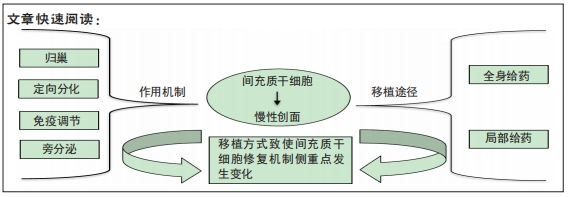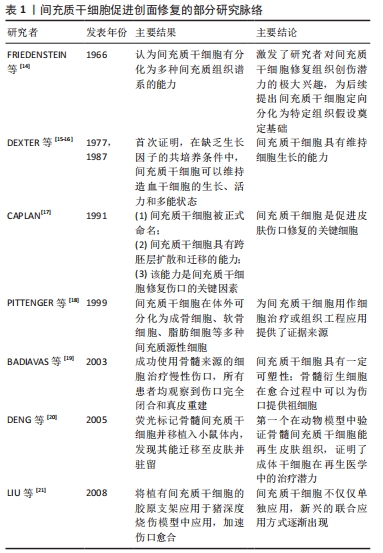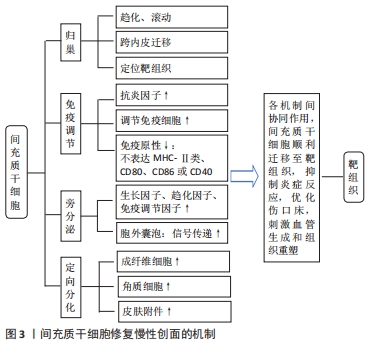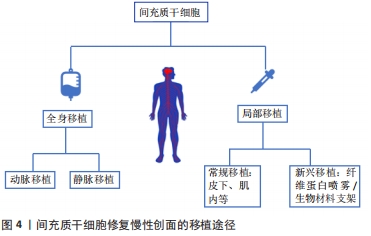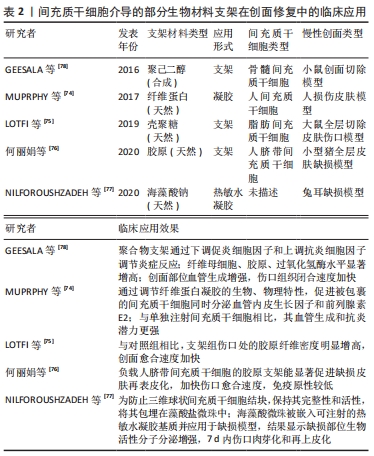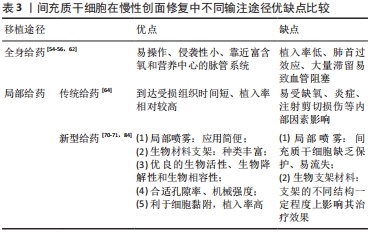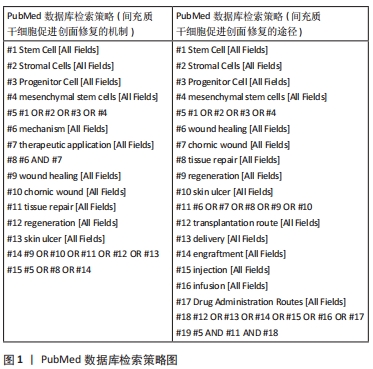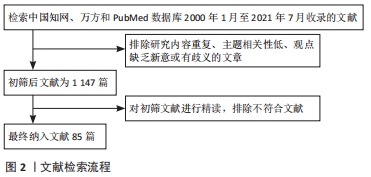[1] 黄琼蕾,金瑛.基于共词分析法探讨中国2010-2019年慢性伤口护理研究热点[J].护理管理杂志,2021,21(2):123-127.
[2] FRYKBERG RG, BANKS J. Challenges in the treatment of chronic wounds. Adv Wound Care.2015;4(9):560-582.
[3] 冯光,宋达疆,章一新,等.创面修复临床研究进展[J].中国美容整形外科杂志,2019,30(11):687-689.
[4] NUSSBAUM SR, CARTER MJ, FIFE CE, et al. An economic evaluation of the impact, cost, and medicare policy implications of chronic nonhealing wounds. Value Health. 2018;21(1):27-32.
[5] KESHTKAR S, AZARPIRA N, GHAHREMANI MH. Mesenchymal stem cell-derived extracellular vesicles: novel frontiers in regenerative medicine. Stem Cell Res Ther. 2018;9(1):63.
[6] LEE BC, KANG KS. Functional enhancement strategies for immunomodulation of mesenchymal stem cells and their therapeutic application. Stem Cell Res Ther. 2020;11(1):397.
[7] CAO Y, GANG X, SUN C, et al. Mesenchymal Stem Cells Improve Healing of Diabetic Foot Ulcer. J Diabetes Res. 2017;2017:9328347.
[8] KEAN TJ, LIN P, CAPLAN AI, et al. MSCs: delivery routes and engraftment, cell-targeting strategies, and immune modulation. Stem Cells Int. 2013;2013:732742.
[9] FAKOYA AO. New delivery systems of stem cells for vascular regeneration in ischemia. Front Cardiovasc Med. 2017;4:7.
[10] GAO L, XU W, LI T, et al. Stem cell therapy: a promising therapeutic method for intracerebral hemorrhage. Cell Transplant. 2018;27(12):1809-1824.
[11] 谢江帆,杨思明,尚涛,等.间充质干细胞用于慢性创面治疗的作用途径及其相关机制[J].感染、炎症、修复,2014,15(4):248-250.
[12] LEE DE, AYOUB N, AGRAWAL DK. Mesenchymal stem cells and cutaneous wound healing: novel methods to increase cell delivery and therapeutic efficacy. Stem Cell Res Ther. 2016;7:37.
[13] MAQSOOD M, KANG M, WU X, et al. Adult mesenchymal stem cells and their exosomes: sources, characteristics, and application in regenerative medicine. Life Sci. 2020;256:118002.
[14] FRIEDENSTEIN AJ, PIATETZKY-SHAPIRO II, PETRAKOVA KV. Osteogenesis in transplants of bone marrow cells. J Embryol Exp Morphol. 1966;16(3):381-390.
[15] DEXTER TM, SPOONCER E. Growth and differentiation in the hemopoietic system. Annu Rev Cell Biol. 1987;3:423-441.
[16] DEXTER TM, WRIGHT EG, KRIZSA F, et al. Regulation of haemopoietic stem cell proliferation in long term bone marrow cultures. Biomedicine. 1977;27(9-10): 344-349.
[17] CAPLAN AI. Mesenchymal stem cells. J Orthop Res. 1991;9(5):641-650.
[18] PITTENGER MF, MACKAY AM, BECK SC, et al. Multilineage potential of adult human mesenchymal stem cells. Science. 1999;284(5411):143-147.
[19] BADIAVAS EV, FALANGA V. Treatment of chronic wounds with bone marrow-derived cells. Arch Dermatol. 2003;139(4):510-516.
[20] DENG W, HAN Q, LIAO L, et al. Engrafted bone marrow-derived flk-(1+) mesenchymal stem cells regenerate skin tissue. Tissue Eng. 2005;11(1-2):110-119.
[21] LIU P, DENG Z, HAN S, et al. Tissue-engineered skin containing mesenchymal stem cells improves burn wounds. Artif Organs. 2008;32(12):925-931.
[22] LIESVELD JL, SHARMA N, Aljitawi OS. Stem cell homing: from physiology to therapeutics. Stem Cells. 2020;38(10):1241-1253.
[23] VOLAREVIC V, GAZDIC M, SIMOVIC MB, et al. Mesenchymal stem cell-derived factors: immuno-modulatory effects and therapeutic potential. Biofactors. 2017; 43(5):633-644.
[24] RUSTER B, GOTTIG S, LUDWIG RJ, et al. Mesenchymal stem cells display coordinated rolling and adhesion behavior on endothelial cells. Blood. 2006; 108(12):3938-3944.
[25] AN T, CHEN Y, TU Y, et al. Mesenchymal stromal cell-derived extracellular vesicles in the treatment of diabetic foot ulcers: application and challenges. Stem Cell Rev Rep. 2021;17(2):369-378.
[26] RUSTAD KC, GURTNER GC. Mesenchymal stem cells home to sites of injury and inflammation. Adv Wound Care. 2012;1(4):147-152.
[27] FU X, LIU G, HALIM A, et al. Mesenchymal stem cell migration and tissue repair. Cells. 2019,8(8):784.
[28] SASAKI M, ABE R, FUJITA Y, et al. Mesenchymal stem cells are recruited into wounded skin and contribute to wound repair by transdifferentiation into multiple skin cell type. J Immunol. 2008;180(4):2581-2587.
[29] LIAO Y, ITOH M, YANG A, et al. Human cord blood-derived unrestricted somatic stem cells promote wound healing and have therapeutic potential for patients with recessive dystrophic epidermolysis bullosa. Cell Transplant. 2014;23(3):303-317.
[30] LANDEN NX, LI D, STAHLE M. Transition from inflammation to proliferation: a critical step during wound healing. Cell Mol Life Sci. 2016;73(20):3861-3885.
[31] BERNARDO ME, FIBBE WE. Mesenchymal stromal cells: sensors and switchers of inflammation. Cell Stem Cell. 2013;13(4):392-402.
[32] GAZDIC M, VOLAREVIC V, ARSENIJEVIC N, et al. Mesenchymal stem cells: a friend or foe in immune-mediated diseases. Stem Cell Rev Rep. 2015;11(2):280-287.
[33] KIM KH, BLASCO-MORENTE G, CUENDE N, et al. Mesenchymal stromal cells: properties and role in management of cutaneous diseases. J Eur Acad Dermatol Venereol. 2017;31(3):414-423.
[34] REGMI S, PATHAK S, KIM JO, et al. Mesenchymal stem cell therapy for the treatment of inflammatory diseases: challenges, opportunities, and future perspectives. Eur J Cell Biol. 2019;98(5-8):151041.
[35] YAGI H, SOTO-GUTIERREZ A, PAREKKADAN B, et al. Mesenchymal stem cells: Mechanisms of immunomodulation and homing. Cell Transplant. 2010;19(6):667-679.
[36] JIANG W, XU J. Immune modulation by mesenchymal stem cells. Cell Prolif. 2020; 53(1):e12712.
[37] ELLOSO M, KAMBLI A, AIJAZ A, et al. Burns in the elderly: potential role of stem cells. Int J Mol Sci. 2020;21(13):4604.
[38] LIU L, YU Y, HOU Y, et al. Human umbilical cord mesenchymal stem cells transplantation promotes cutaneous wound healing of severe burned rats. PLoS One. 2014;9(2):e88348.
[39] RASULOV MF, VASILENKO VT, ZAIDENOV VA, et al. Cell transplantation inhibits inflammatory reaction and stimulates repair processes in burn wound. Bull Exp Biol Med. 2006;142(1):112-115.
[40] XING X, LI Z, YANG X, et al. Adipose-derived mesenchymal stem cells-derived exosome-mediated microRNA-342-5p protects endothelial cells against atherosclerosis. Aging (Albany NY). 2020;12(4):3880-3898.
[41] VIZOSO FJ, EIRO N, CID S, et al. Mesenchymal stem cell secretome: toward cell-free therapeutic strategies in regenerative medicine. Int J Mol Sci. 2017;18(9): 3880-3898.
[42] GUNAWARDENA T, RAHMAN MT, ABDULLAH B, et al. Conditioned media derived from mesenchymal stem cell cultures: the next generation for regenerative medicine. J Tissue Eng Regen Med. 2019;13(4):569-586.
[43] BOULESTERAU J, MAUMUS M, ROZIER P, et al. Mesenchymal stem cell derived extracellular vesicles in aging. Front Cell Dev Biol. 2020;8:107.
[44] JAKOVLJEVIC J, HARRELL CR, FELLABAUM C, et al. Modulation of autophagy as new approach in mesenchymal stem cell-based therapy. Biomed Pharmacother. 2018;104:404-410.
[45] ZHANG Y, HAO Z, WANG P, et al. Exosomes from human umbilical cord mesenchymal stem cells enhance fracture healing through HIF-1α-mediated promotion of angiogenesis in a rat model of stabilized fracture. Cell Prolif. 2019; 52(2):e12570.
[46] PHAN J, KUMAR P, HAO D, et al. Engineering mesenchymal stem cells to improve their exosome efficacy and yield for cell-free therapy. J Extracell Vesicles. 2018; 7(1):1522236.
[47] FUI LW, LOK M, GOVINDASAMY V, et al. Understanding the multifaceted mechanisms of diabetic wound healing and therapeutic application of stem cells conditioned medium in the healing process. J Tissue Eng Regen Med. 2019; 13(12):2218-2233.
[48] QIU H, LIU S, WU K, et al. Prospective application of exosomes derived from adipose-derived stem cells in skin wound healing: a review. J Cosmet Dermatol. 2020;19(3):574-581.
[49] HU P, YANG Q, WANG Q, et al. Mesenchymal stromal cells-exosomes: a promising cell-free therapeutic tool for wound healing and cutaneous regeneration. Burns Trauma. 2019;7:38.
[50] LI H, FU X. Mechanisms of action of mesenchymal stem cells in cutaneous wound repair and regeneration. Cell Tissue Res. 2012;348(3):371-377.
[51] MARANDA EL, RODRIGUEZ-MENOCAL L, BADIAVAS EV. Role of mesenchymal stem cells in dermal repair in burns and diabetic wounds. Curr Stem Cell Res Ther. 2017;12(1):61-70.
[52] ZHOU SB, CHIANG CA, LIU K, et al. Intravenous transplantation of bone marrow mesenchymal stem cells could effectively promote vascularization and skin regeneration in mechanically stretched skin. Br J Dermatol. 2015;172(5):1278-1285.
[53] NIE C, YANG D, XU J, et al. Locally administered adipose-derived stem cells accelerate wound healing through differentiation and vasculogenesis. Cell Transplant. 2011;20(2):205-216.
[54] DE BECKER A, RIET IV. Homing and migration of mesenchymal stromal cells: how to improve the efficacy of cell therapy? World J Stem Cells. 2016;8(3):73-87.
[55] EVANS CE, PALAZON A, SIM J, et al. Modelling pulmonary microthrombosis coupled to metastasis: distinct effects of thrombogenesis on tumorigenesis. Biol Open. 2017;6(5):688-697.
[56] BRAID LR, WOOD CA, WIESE DM, et al. Intramuscular administration potentiates extended dwell time of mesenchymal stromal cells compared to other routes. Cytotherapy. 2018;20(2):232-244.
[57] GAO J, DENNIS JE, MUZIC RF, et al. The dynamic in vivo distribution of bone marrow-derived mesenchymal stem cells after infusion. Cells Tissues Organs. 2001;169(1):12-20.
[58] DE WITTE S, LUK F, SIERRA PJ, et al. Immunomodulation by therapeutic mesenchymal stromal cells (MSC) is triggered through phagocytosis of msc by monocytic cells. Stem Cells. 2018;36(4):602-615.
[59] JANOWSKI M, LYCZEK A, ENGELS C, et al. Cell size and velocity of injection are major determinants of the safety of intracarotid stem cell transplantation. J Cereb Blood Flow Metab. 2013;33(6):921-927.
[60] CUI LL, KERKELA E, BAKREEN A, et al. The cerebral embolism evoked by intra-arterial delivery of allogeneic bone marrow mesenchymal stem cells in rats is related to cell dose and infusion velocity. Stem Cell Res Ther. 2015;6(1):11.
[61] ZHAO QS, XIA N, ZHAO N, et al. Localization of human mesenchymal stem cells from umbilical cord blood and their role in repair of diabetic foot ulcers in rats. Int J Biol Sci. 2013;10(1):80-89.
[62] GE J, GUO L, WANG S, et al. The size of mesenchymal stem cells is a significant cause of vascular obstructions and stroke. Stem Cell Rev Rep. 2014;10(2):295-303.
[63] POLTAVTSEVA RA, POLTAVTSEV AV, LUTSENKO GV, et al. Myths, reality and future of mesenchymal stem cell therapy. Cell Tissue Res. 2019;375(3):563-574.
[64] HUSELSTEIN C, RAHOUADJ R, DE ISLA N, et al. Mechanobiology of mesenchymal stem cells: Which interest for cell-based treatment? Biomed Mater Eng. 2017;28(s1):S47-S56.
[65] DASH NR, DASH SN, ROUTRAY P, et al. Targeting nonhealing ulcers of lower extremity in human through autologous bone marrow-derived mesenchymal stem cells. Rejuvenation Res. 2009;12(5):359-366.
[66] WAN J, CAI Q, LIU Y. Effect of different transplantations with bone-marrow derived mesenchymal stem cells on diabetic foot ulcers in rats. Zhong Nan Da Xue Xue Bao Yi Xue Ban. 2013;38(4):347-355.
[67] GARG RK, RENNERT RC, DUSCHER D, et al. Capillary force seeding of hydrogels for adipose-derived stem cell delivery in wounds. Stem Cells Transl Med. 2014; 3(9):1079-1089.
[68] ZHANG M, METHOT D, POPPA V, et al. Cardiomyocyte grafting for cardiac repair: graft cell death and anti-death strategies. J Mol Cell Cardiol. 2001;33(5):907-921.
[69] FALANGA V, IWAMOTO S, CHARTIER M, et al. Autologous bone marrow-derived cultured mesenchymal stem cells delivered in a fibrin spray accelerate healing in murine and human cutaneous wounds. Tissue Eng. 2007;13(6):1299-1312.
[70] KOHANE DS, LANGER R. Polymeric biomaterials in tissue engineering. Pediatr Res. 2008;63(5):487-491.
[71] GUO B, MA PX. Conducting polymers for tissue engineering. Biomacromolecules. 2018;19(6):1764-1782.
[72] TURNER NJ, BADYLAK SF. The use of biologic scaffolds in the treatment of chronic nonhealing wounds. Adv Wound Care (New Rochelle). 2015;4(8):490-500.
[73] DASH BC, Xu Z, LIN L, et al. Stem Cells and Engineered Scaffolds for Regenerative Wound Healing. Bioengineering (Basel). 2018;5(1):23.
[74] MURPHY KC, WHITEHEAD J. Engineering fibrin hydrogels to promote the wound healing potential of mesenchymal stem cell spheroids. Acta Biomater. 2017;64: 176-186.
[75] LOTFI M, NADERI-MESHKIN H, MAHDIPOUR E, et al. Adipose tissue-derived mesenchymal stem cells and keratinocytes co-culture on gelatin/chitosan/β-glycerol phosphate nanoscaffold in skin regeneration. Cell Biol Int. 2019. doi: 10.1002/cbin.11119.
[76] 何丽娟,张博文,贾雅丽,等.人脐带间充质干细胞复合胶原支架治疗小型猪皮肤缺损的实验研究[J].军事医学,2020,44(3):192-197.
[77] NILFOROUSHZADEH MA, KHODADADI YM, BARADARAN GS, et al. Mesenchymal stem cell spheroids embedded in an injectable thermosensitive hydrogel: an in situ drug formation platform for accelerated wound healing. ACS Biomater Sci Eng. 2020;6(9):5096-5109.
[78] GEESALA R, BAR N, DHOKE NR, et al. Porous polymer scaffold for on-site delivery of stem cells--Protects from oxidative stress and potentiates wound tissue repair. Biomaterials. 2016;77:1-13.
[79] KIM CH, LEE JH, WON JH, et al. Mesenchymal stem cells improve wound healing in vivo via early activation of matrix metalloproteinase-9 and vascular endothelial growth factor. J Korean Med Sci. 2011;26(6):726-733.
[80] NIE C, ZHANG G, YANG D, et al. Targeted delivery of adipose-derived stem cells via acellular dermal matrix enhances wound repair in diabetic rats. J Tissue Eng Regen Med. 2015;9(3):224-235.
[81] CHEN Z, ZHANG B, SHU J, et al. Human decellularized adipose matrix derived hydrogel assists mesenchymal stem cells delivery and accelerates chronic wound healing. J Biomed Mater Res A. 2021;109(8):1418-1428.
[82] RUSTAD KC, WONG VW, SORKIN M, et al. Enhancement of mesenchymal stem cell angiogenic capacity and stemness by a biomimetic hydrogel scaffold. Biomaterials. 2012;33(1):80-90.
[83] FU J, ZHANG Y, CHU J, et al. Reduced graphene oxide incorporated acellular dermal composite scaffold enables efficient local delivery of mesenchymal stem cells for accelerating diabetic wound healing. ACS Biomater Sci Eng. 2019;5(8):4054-4066.
[84] QAZI TH, MOONEY DJ, DUDA GN, et al. Biomaterials that promote cell-cell interactions enhance the paracrine function of MSCs. Biomaterials. 2017;140:103-114.
[85] SALAZAR-NORATTO GE, LUO G, DENOEUD C, et al. Understanding and leveraging cell metabolism to enhance mesenchymal stem cell transplantation survival in tissue engineering and regenerative medicine applications. Stem Cells. 2020;38(1):22-33.
|
